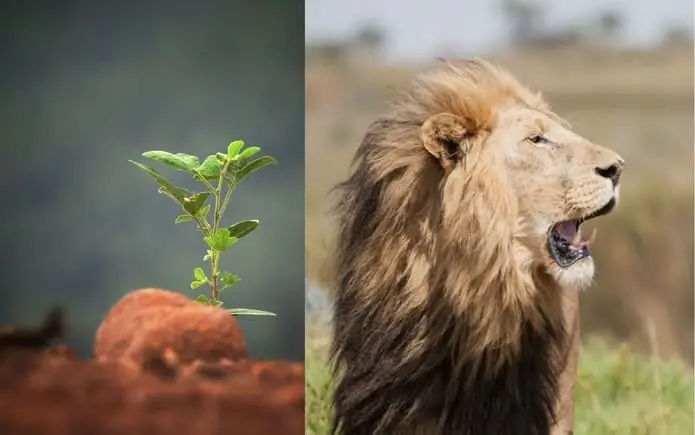Our eco-system is abound with diverse organisms, ranging from microscopic bacteria to the 30 meter wide blue whale. While every organism is distinct in its own way, we do have some things in common. We are all made up of miniature factories called “cells”, which perform all the functions necessary to grow, reproduce, repair, move and defend against invaders. However, like most machines, these factories also need energy to operate; energy which the organism must obtain from the environment.
All living organisms can be classified as Autotrophs or Heterotrophs based on the way they obtain and store energy which we commonly refer to as “food”. Autotrophs produce their own food and Heterotrophs consume food and break it down to extract energy.
| AUTOTROPHS | HETEROTROPHS |
|---|---|
| They produce their own food. | They depend on autotrophs for food. |
| They depend on energy from the sun in order to produce food. | Heterotrophs depend on the sun’s energy indirectly. |
| They produce organic substances from inorganic substances by using photosynthesis. | They ingest organic substances and break it down into chemical energy. |
| All autotrophs contain pigmented specialized components which can absorb energy from their environment. E.g. chlorophyll | Heterotrophs do not need these pigments. |
| Require carbon dioxide for energy production. | Require oxygen for obtaining energy. |
To understand the processes involved with energy production among and between Autotrophs and Heterotrophs we must first look at the flow of energy within an ecosystem, and the distinct methods by which organisms capture and use energy.
Energy Flow
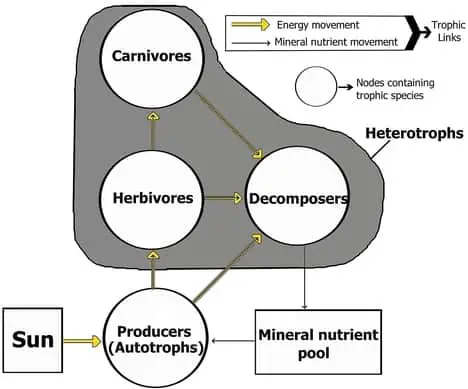
Most of the energy that powers living organisms is derived from the sun. Plants capture this sunlight and transform it into a form of energy that can be used to carry out its essential functions. Animals (Herbivores and carnivores) subsequently obtain this energy by consuming plants.
Decomposers (bacteria and other microorganisms) feed on dead animals to obtain energy, thereby forming a continuous food chain linked together by the flow of energy. In the 19th century, naturalists believed all organisms in nature were linked together through food.
Jan Ingenhousz in the late 18th century had discovered photosynthesis, the process by which plants capture sunlight to produce energy. In this period, organisms were broadly classified into two classes; producers (plants which produced food) and consumers (animals who consumed producers).
The beginning of the 20th century brought the discovery of thermodynamics, with the second law of thermodynamics proving that total entropy of an isolated system can never decrease over time. Thus, began the journey to the elucidation of food chains and food webs – where energy (typically obtained from the sun) is conserved within an ecosystem. The Image below describes an example of a typical oceanic ecosystem.
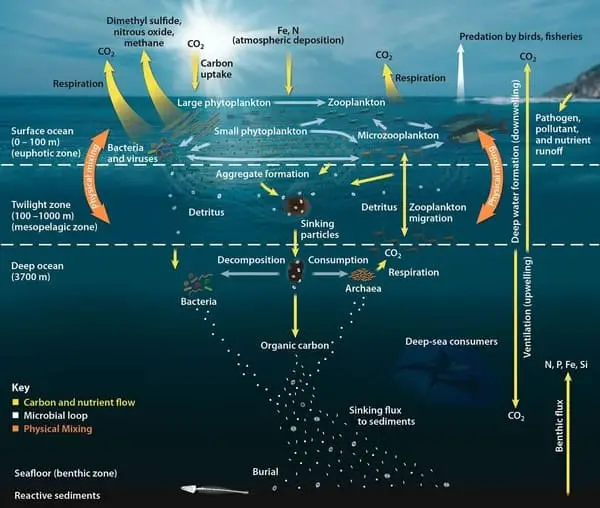
Energy Conversion
Energy can be simplistically defined as the ability to do work. All organisms need energy to perform a distinct set of functions. Picture an apple tree in a garden. Trees need to propagate their seeds in order to form more copies of themselves survive.
The apple tree uses energy derived from the sun to form fruits. An animal who now wishes to eat this apple, must use its own energy to pluck, bite and chew the fruit. The seeds inside the fruit are then dropped by the animals in the soil, which grow to form new apple trees.
For every action described above, a chemical reaction takes place inside the body that transforms energy from one form into another. This study of energy flow in organisms is called “bioenergetics”.
Energy Chemistry
Every organism is unique in the way it uses energy. However, there are some things in common between all organisms. Most organisms obtain energy by breaking highly complex molecules into simple molecules thereby releasing energy in the form of electrons.
The removal of an electron from a molecule occurs via oxidation, while an addition of an electron occurs through a process called reduction. The removal of an electron releases energy while the addition of an electron will require energy.
Energy Molecules
Most living organisms use specialised molecules as electron carriers, like a shuttle bus that transfers electrons from one compound to another. Nicotinamide Adenine Dinucleotide (NAD) can shift between two forms; NAD+(electron acceptor) and NADH(electron giver). Interestingly, the NAD complex always loses or gains electrons in twos! Flavin Adenine Dinucleotide (FAD) is another electron carrier which is commonly used by plants.
How do Organisms Store Energy?
What happens after an organism obtains energy? Cells cannot simply store free energy like machines in the factories do. Machines generally have moving parts that store potential energy. But a cell is a fragile system. Any excessive energy could generate heat that could destroy its structure. So cells store energy in the form of a compound molecule called Adenosine triphosphate (ATP), commonly called the energy currency of the cell.
Energy is obtained from ATP using a process called hydrolysis. Hydrolysis is where a water molecule has a disintegration of a chemical bond. The energy released from this chemical reaction is then used to release energy from ATP.
Therefore, every action performed by the organism requires the continuous breakdown of ATP. Collectively, all the chemical reactions taking place inside cells in order to acquire, store and release energy is referred to as metabolism. Metabolic reactions are critical to an organism’s survival. When metabolism stops, the organism dies.
Autotrophs and Heterotrophs
Naturally, prior to energy conversion and storage, energy must be obtained from the environment. We commonly refer to energy stores as “food” but chemically, these are complex organic compounds that can be broken down by living organisms.
Based on the method by which food is acquired, organisms can be divided into two categories; Autotrophs and Heterotrophs. Autotrophs are capable of producing their own energy by capturing energy from the environment. Heterotrophs, on the other hand, must consume food which is then broken down to release energy.
What are Autotrophs?
All green leaved plants are autotrophs and therefore, capable of producing their own food. The process by which plants build organic materials using sunlight and water is called photosynthesis. Photosynthesis is a fairy simplistic process compared to the metabolic reactions taking place in other organisms.
The plants take in carbon dioxide, sunlight and water, in order to produce carbohydrates, oxygen and water. Therefore, in addition to producing food for 99% of the ecosystem, they also carry out the conversion of carbon dioxide to oxygen, the most critical process to sustaining life on earth.
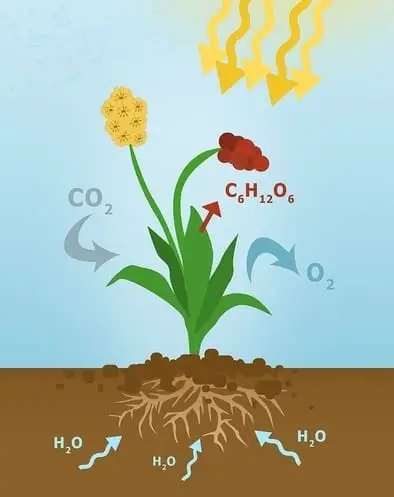
Autotrophs occupy the base of the food chain in the ecosystem. Thus no other organism on earth, even carnivores that do not directly consume plants, can survive without these primary producers.
The simplified equation of photosynthesis can be expressed in the following way:
Carbon dioxide + Water + Energy → Sugar + Oxygen.
Apart from producing oxygen and food, Autotrophs also form mutually beneficial relationships with other organisms called symbiotic relationships. For example, the Rhizobium bacteria present on roots of legume plants help the plant obtain nitrogen. In turn, the plant provides the bacteria with nutrients it needs to survive.
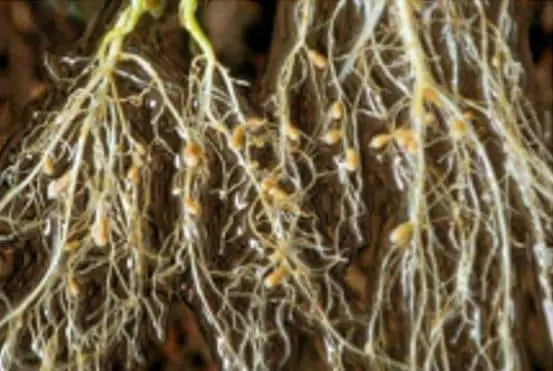
Photosynthesis can be collectively split into two steps, the light dependent and the light independent phases.
Light Dependent Phase
Light Dependent reactions, as the name implies, can only occur in the presence of sunlight. Plants absorb light energy and use it to power the breakdown of water. However, as we saw before, plants cannot store free electrons in their cells as an energy source. So, these free electrons are transferred into chemical energy stores such as NADPH and ATP.
Although Cacti are autotrophs that can produce their own energy, they have limited access to water, an essential component of photosynthesis. In order to conserve water, cactus prepare materials for photosynthesis in the night, even in the absence of sunlight by using modifications of the light dependent phase.
This is because in the cool temperatures of the night, the stomata remain closed enough to preserve water but still slightly open to allow carbon dioxide to be absorbed.

Light Independent Phase
The next phase of photosynthesis involves the conversion of carbon dioxide to sugar molecules. These reactions no longer require light, because all the energy the plant needs has already been captured and stored in the form of ATP and NADPH.
However, the formation of glucose (which contains 6 carbons) from carbon dioxide (one carbon) is itself a complicated chemical reaction which occurs in a stepwise manner. Finally, the glucose molecules can be combined to form other forms of sugars. However, most plants generally store energy in the form of starch.
Ceullular Respiration
When plant cells need energy, starch (which is a complex carbohydrate) is broken down into simpler molecules like glucose, thus releasing energy. This process is called cellular respiration and occurs through a complex series of chemical reactions
Carbohydrate + Oxygen → Carbon dioxide +Water + energy
The energy that is released through cellular respiration is used to form ATP molecules which serve as the energy currency of the cell. Just as humans use money to pay for goods, cells use ATP to carry out all essential functions.
The carbon dioxide thus released from cellular respiration is recycled to be used in photosynthesis. Thus, photosynthesis and cellular respiration occur in harmony, forming the basis of sustenance for all life on earth.
Where Does Photosynthesis Occur?
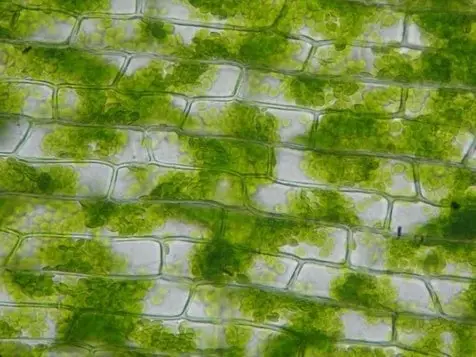
The capture of sunlight requires specialized molecules called chloroplasts. The green leaves of a plant function like solar panels. In just one millimeter square of a leaf there are over half a million chloroplasts. Chloroplasts contain green-pigments called chlorophyll which gives leaves their characteristic color.
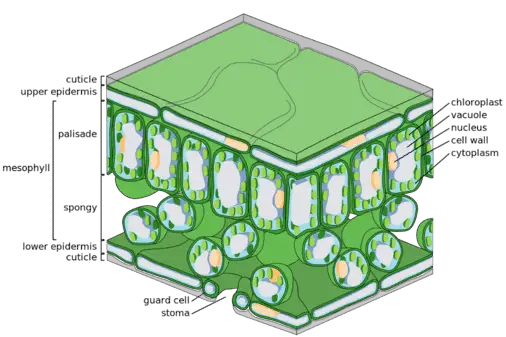
Although leaves appear thin, they are made up of several layers of distinct cells arranged over each other. The site of both sunlight absorption and photosynthesis – the chloroplasts are present in the middle layer called mesophyll.
Furthermore, the underside of the leaf has small openings called stomata through which both gaseous exchange and water exchange occurs. However, if these stoma are always open, all the essential water required by leaves would leak outside.
Therefore, the opening of stoma is highly regulated by the guard cells enclosing them. When excess water is present, the guard cells swell up, thus opening the stoma. In all other times, the guard cells remain shrunken thus keeping the stoma closed.
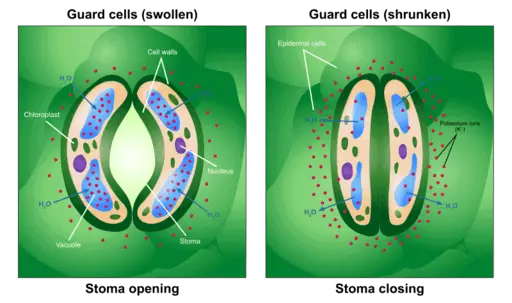
Photoautotrophs
Autotrophs that use energy obtained from the sun in order to carry out photosynthesis are called photoautotrophs; photo meaning light. Most green leaved plants, algae and cyanobacteria fall into this category. Some organisms are capable of carrying out photosynthesis while producing oxygen. On the other hand, obligate anaerobes such as purple bacteria carry out anoxygenic photosynthesis without the release of oxygen.
Chemoautotrophs
Chemoautotrophs also called chemosynthetic organisms are autotrophs that do not use light. Instead they synthesise sugars by deriving energy from chemical compounds present in the environment. Therefore, these organisms do not require sunlight in order to survive.
Chemoautotrophs that derive energy from organic compounds are called chemoorganotrophs while those that use inorganic molecules are called chemolithotrophs. This category includes bacteria that live deep under the sea beyond the reach of light.
A species of bacteria called ‘Cyanobacteria’ are capable of photosynthesis. Unlike other bacteria, these organisms release oxygen through photosynthesis, just like plants! Here is an aggregation of cyanobacteria on the surface of a lake.
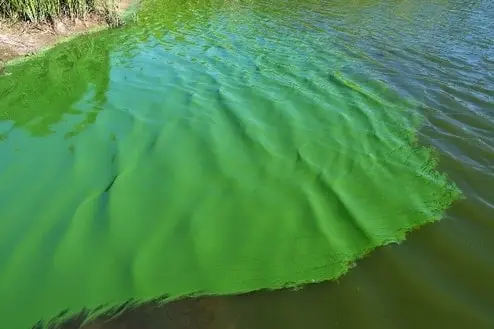
What are Heterotrophs?
Heterotrophs or “consumers” are organisms that are incapable of producing their own food. Therefore, they obtain energy by ingesting organic compounds and materials in the environment. This category includes organisms ranging from microscopic bacteria to mammals such as humans.
While autotrophs form the base of the food chain, heterotrophs occupy the upper levels. The first law of thermodynamics states that energy can never be destroyed, it is merely converted from one form to another. Similarly, in the ecosystem, energy is always conserved between organisms. Although different organisms may use energy in different forms, it is never wasted.
Where do Heterotrophs Obtain Energy?
All heterotrophs obtain energy by ingesting organic molecules. However, based on the source of organic molecules, these organisms can be classified into distinct categories. The most common types of Heterotrophic nutrition are described below.
Saprotrophic Nutrition
Saprotrophs or saprophytes absorb nutrients from decaying organic matter, such as dead and decomposing animals and plants. This category includes most fungi and bacteria.
Saprophytes release special proteins called enzymes which bind to the decaying substance and break it into smaller molecules which can then be easily absorbed. In order to facilitate absorption, saprophytes may contain distinct features.
For example, the Mucor, a type of fungi contains thin thread-like filaments all over its surface called hyphae. These fungi grow on organisms (plants, animals) or substances (bread) by using their hyphae to infiltrate and absorb nutrients. Through these hyphae, the fungi releases digestive enzymes which penetrate the decaying substance and break it into simpler molecules.
On the other hand single celled organisms such as yeast, obtain nutrition by carrying out digestion outside their body. Yeast can detect certain ideal conditions in the environment including the presence of moisture, oxygen, warm temperature and acidic pH. When the conditions are suitable, the yeast releases digestive enzymes which break down organic materials in its surrounding, thus facilitating absorption.
Saprophytes play an important role in the ecosystem by breaking down organic wastes produced by all other organisms. Additionally, saprophytes also play a role in the decomposing of dead organisms, thus transferring nutrients into the soil. Subsequently, plants take up these nutrients through their roots in order to carry out important functions.
Some fungi like mushrooms are also eaten by both humans and other animals. Interestingly, many saprophytes have also been adopted for use industry. Humans use saprophytes to break down organic matter and form manure which can be used in farming. In the food industry, saprophytes are used in the production of fermented products such as vinegar.
Some organisms other than bacteria and fungi can also exhibit saprotrophic nutrition. Water molds are small filamentous organisms which float in water. They obtain nutrition by absorbing organic materials from dead insects and fishes.
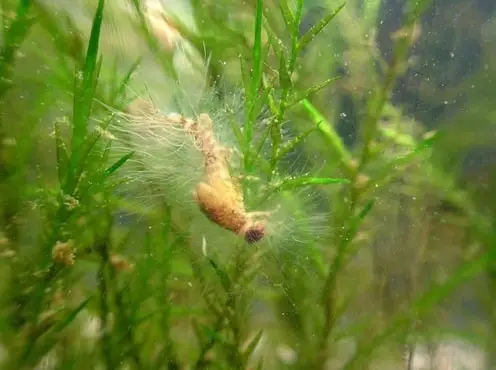
Holozoic Nutrition
Holozoic is derived from the Greek words Holo and Zoic meaning whole and animal respectively. Holozoic organisms ingest solid food materials from the environment, before breaking them into simpler substances within their body.
This category includes humans, mammals and other smaller organisms like amoebas. Based on what they ingest, Holozoic organisms can be further classified into three categories: Herbivores, Carnivores, and Omnivores.
Herbivores
These animals only consume plants or parts of plants. They have specialized structures that enable them to chew up plants and break it into smaller particles that can subsequently be digested using enzymes. For example, a giraffe has special sturdy tongues that enable them to eat from plants riddled with thorns.
Browsers (Goats) are herbivores that feed on plant leaves, roots, fruits etc while Grazers such as cows typically feed on grass. Herbivores typically constitute the bottom of the food chain, placing them just above autotrophs. Apart from being a link in the food chain, these animals also help in the reproduction of plants. As we discussed previously, although plants produce seeds, they cannot disperse it themselves.
Herbivores like bees and elephants help transfer seeds by feeding on the plants. Sheep are herbivores that have specialized features that allow them to eat both plants and grass. They have a narrow muzzle for chewing plants and a wide intestine for digesting grass. These animals are therefore called intermediate feeders, a combination of browsers and grazers.

Carnivores
Carnivores typically only eat meat by killing other animals. For this purpose, carnivores have evolved specialised features that allow them to hunt, kill and bite into animal flesh. For example, while wild cats such as lions have specialized canines which tear into flesh, snakes have poisonous fangs and eagles have sharp claws.
However, these animals don’t just eat herbivores. Many carnivores on top of the food chain can even feed on carnivores and omnivores lower in the food chain. Interestingly, food chain hierarchies do not apply all the time!
Lions are popularly known as the king of the jungle because they are widely feared predators. But animals like hyenas can easily kill and eat small lion cubs which haven’t been trained in hunting. Since carnivores typically need more energy to both hunt and eat meat, their metabolism runs much higher than their fellow herbivores.

Omnivores
These animals feed on both plants and animals. Due to this adaptability, these animals are capable of surviving in a wide array of environments, rich in either plants or animals. Furthermore, this allows these animals to procure nutrients that are specific to only plants or animals. For example, omega acids required by humans are widely available in animals, but rare to find in plants.
Omnivores include most humans, bears, racoons etc. Omnivores have adaptive features that are modified to ingest both plants and animals. For example, humans have sharp canines which enable us to bite into flesh. At the same time, we have flat molar teeth that allow us to chew plant-based foods into small particles which can be digested.
Parasitic Nutrition
Parasites typically do not have any means to hunt or obtain food for themselves, therefore these organisms are completely dependent on other organisms for nutrition. This type of relationship between organisms is referred to as a parasitic relationship, with the provider being called the host. As opposed to symbiotic relationships, that were previously described, these relationships are never mutually beneficial.
In fact, some parasitic relationships could also cause significant harm to the host. Examples of some common parasites include mosquitos, leeches and bed bugs. Depending on their abilities, parasites can be further divided into two categories. Endoparasites need to live inside the host, depending on them for food, shelter and other resources. On the other hand, partial parasites only obtain food from their hosts.
Not all parasites are animals, some of them can even be plants. Rafflesia, also called the monster flower is the largest flower on the planet. Most found in the forests of South East Asia, this flower is over one meter in diameter, weighing over 24 pounds. These plants do not have any leaves or shoots which can help produce food. While insects help propagate sticky pollen found inside these flowers, they obtain their nutrients by stealing from roots and vines.
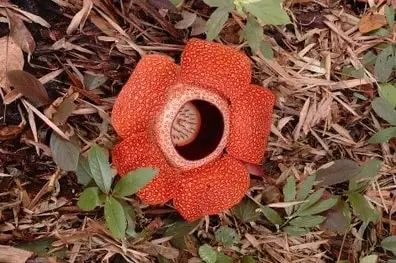
How do Heterotrophs Obtain Energy from Food?
The food that heterotrophs consume can contain a diverse range of molecules which can be collectively grouped into carbohydrates, proteins, fats, vitamins and minerals. Each of these molecules are broken down into their simplest forms using special proteins and features that is distinct to each animal.
Just like a wind-mill converts energy from the wind into mechanical energy which can then be transported to individual homes, heterotrophs convert energy from food into chemical energy (ATP) which can delivered to every cell in the body. This is achieved by a process called cellular respiration.
Cellular respiration can be simplistically represented by the following equation:
Carbohydrate + Oxygen → Carbon dioxide + Water + ATP
However, in reality, this process is quite complex and takes place over four distinct steps. In most organisms, cellular respiration takes place in the mitochondria. Mitochondria is a specialized compartment inside the cell. For this reason, the mitochondria is also referred to as the power house of the cell. For more on mitochondria see Cell Organelles: The Organs of the Cell.
As you can see, cellular respiration requires oxygen. But not all heterotrophs have means of obtaining oxygen. In such cases, an alternate means of obtaining energy is called anaerobic respiration or fermentation. Unlike aerobic respiration, fermentation takes place in the cytoplasm. However, more energy is produced through aerobic respiration than fermentation.
Therefore, this process is rarely used. Fermentation has also been adapted by humans for use in the food industry to produce yogurts, beer and other products. You know how sometimes we get cramps in our muscle during intense physical activity? This can be attributed to Anaerobic respiration or fermentation.
While exercising, some parts of our body may not have immediate access to oxygen supply due to interrupted blood circulation. In such cases the body uses fermentation to produce energy leading to accumulation of lactate, which causes the cramp or pain like symptoms. So the best way to put an end to these cramps is to immediately rest the limb and massage the muscle to increase blood flow to the area.
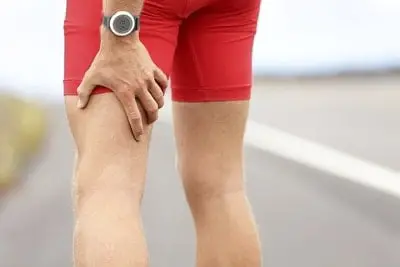
Takeaways
Our ecosystem is highly interconnected, and every organism has a place and serves a purpose. Energy from one animal gets produced, transferred, and recycled throughout the food chain, perpetuating this amazingly complex and dynamic circle of life.
I hope this article has given you an appreciation for all living things and how important they all are to the survival of other animals as well as ourselves. From the smallest bacteria to the largest animals on the planet, no none are insignificant.
References
- Anderson, John W. (1980). Bioenergetics of autotrophs and heterotrophs. London : E. Arnold
- González-Toril E. (2011) Autotroph. In: Gargaud M. et al. (eds) Encyclopedia of Astrobiology. Springer, Berlin, Heidelberg
- Han, H., Hemp, J., Pace, L. A., Ouyang, H., Ganesan, K., Roh, J. H., Daldal, F., Blanke, S. R., & Gennis, R. B. (2011). Adaptation of aerobic respiration to low O2 environments. Proceedings of the National Academy of Sciences, 108(34), 14109–14114. https://doi.org/10.1073/pnas.1018958108
- Reece, J. B., & Campbell, N. A. (2011). Campbell biology. Boston: Benjamin Cummings / Pearson.
- Schönheit, P., Buckel, W., & Martin, W. F. (2016). On the Origin of Heterotrophy. Trends in Microbiology, 24(1), 12–25. https://doi.org/10.1016/j.tim.2015.10.003
- Spencer, H. (1864). The Principles of Biology. Williams and Norgate.

